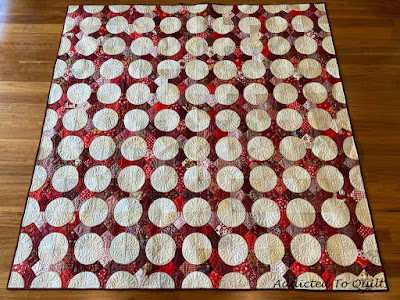I frequently piece my backs.
This is an example of a quilt I made called
Illumination in 2006, so you can see I have been piecing my backs for a while now. I used up leftover squares from the top and several other fabrics from my stash.
I like to piece my backs for many reasons - I like to finish off the fabric I have used in the top rather than put it back into my stash. I also like to use up leftover blocks or cut pieces from the top in the back. As fabric is expensive, I would prefer to use up pieces from my stash rather than buy more fabric just for the back. And finally, I think it looks good.
When piecing the back for loading on a long arm machine, there are some things to take into consideration.
- The back will be loaded between two rollers. Two opposite sides of the back need to be straight and square as these are going to be pinned to the rollers (it is preferable if all four sides are square).
- Piecing the back in long strips is a good options as I will load it so all the seams will run lengthwise on the roller.
- If you are able, leave the selvage on the outer edge of the two opposite sides, this makes pinning onto the canvas rollers easier, and I will know they are straight.
- Remove all selvages on seams within the back as this reduces bulk and the slight puckering that can occur due to the selvage being woven more tightly.
- Seams can be pressed either open or to one side. Pressing seams open will give you a flatter back, pressing seams to one side will give you a more secure seam. Either option is fine so long as the seams are carefully pressed. I press my seams to one side.
- Unless I am given specific instructions, I will off centre the seam in the back so it is not in the middle of the quilt, as that is where the quilt is more likely to be folded.
- I can roughly centre a quilt on a back, but it can't be done exactly. Therefore backs with borders can't be perfectly centred so if the final border is narrow it will be noticeable.
- It is difficult to get a quilt perfectly straight on all sides of a back, therefore a random pieced back with wide pieces falling at the edges is preferable.
- I can't see the back when I am quilting, so the piecing needs to be flat and straight.
Here are some more examples of pieced backs on my quilts.
In this quilt I had one star block left over from the top and pieced it into the back so I could call the quilt
50 Stars instead of 49 Stars.
I had a whole lot of red strips as offcuts from another quilt I was making where I was fussing cut the red fabric, and these were the left over pieces. I pieced them into the back of this quilt so they weren't wasted.
You can see that the top and bottom of the back of this quilt are wide pieces of fabric, and I put the narrow strips into the centre of the quilt. That way if the quilt is slightly out of shape or not perfectly square (almost no quilts are perfect), you can't notice if the wide strips are not exactly even on each side.
I decided to not piece the blocks into the setting triangle like in Jen's pattern so I had leftover blocks. In the back I pieced in the extra blocks and I offset them in a vertical line as I didn't have enough of the lighter fabric to make the width of the quilt (normally I would put them in a horizontal line).
Many of the fabric in this quilt were purchased when visiting a friend in Canada. She gave me a packet of two-inch strips as a present. At the time, I didn't know where I would use these fabric, but I felt they should be part of this quilt so I pieced them into the back in a horizontal line.
The lowest horizontal strip of light green fabric was not meant to be there. However I miscalculated the size of the backing, and didn't realise until I had almost finished quilting it that I was going to run out of backing. So I took the quilt off the machine, although it was already mostly quilted, and pieced the light green strip of fabric into the back.
I would not normally have pieced a strip that low into the bottom of a quilt back. As a consequence, the strip is not even (Look a the bottom left of the picture and you can see the dark green strip is lightly narrower than the other side). Still, the strip is wide enough that it is not hugely noticeable. It would have been much more noticeable if it was narrower.
-












